
Lesson 11 Package Printing 第11课 包装印刷
Lesson 11 Package Printing 第11课 包装印刷
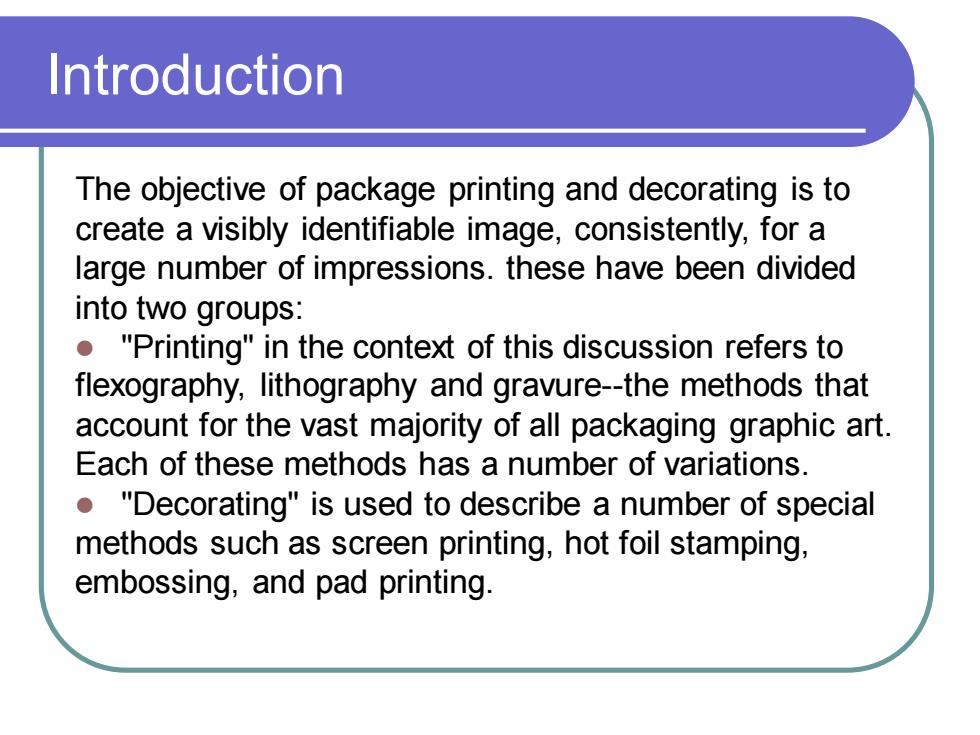
Introduction The objective of package printing and decorating is to create a visibly identifiable image, consistently, for a large number of impressions. these have been divided into two groups: ⚫ "Printing" in the context of this discussion refers to flexography, lithography and gravure-the methods that account for the vast majority of all packaging graphic art. Each of these methods has a number of variations. ⚫ "Decorating" is used to describe a number of special methods such as screen printing, hot foil stamping, embossing, and pad printing
Introduction The objective of package printing and decorating is to create a visibly identifiable image, consistently, for a large number of impressions. these have been divided into two groups: ⚫ "Printing" in the context of this discussion refers to flexography, lithography and gravure-the methods that account for the vast majority of all packaging graphic art. Each of these methods has a number of variations. ⚫ "Decorating" is used to describe a number of special methods such as screen printing, hot foil stamping, embossing, and pad printing
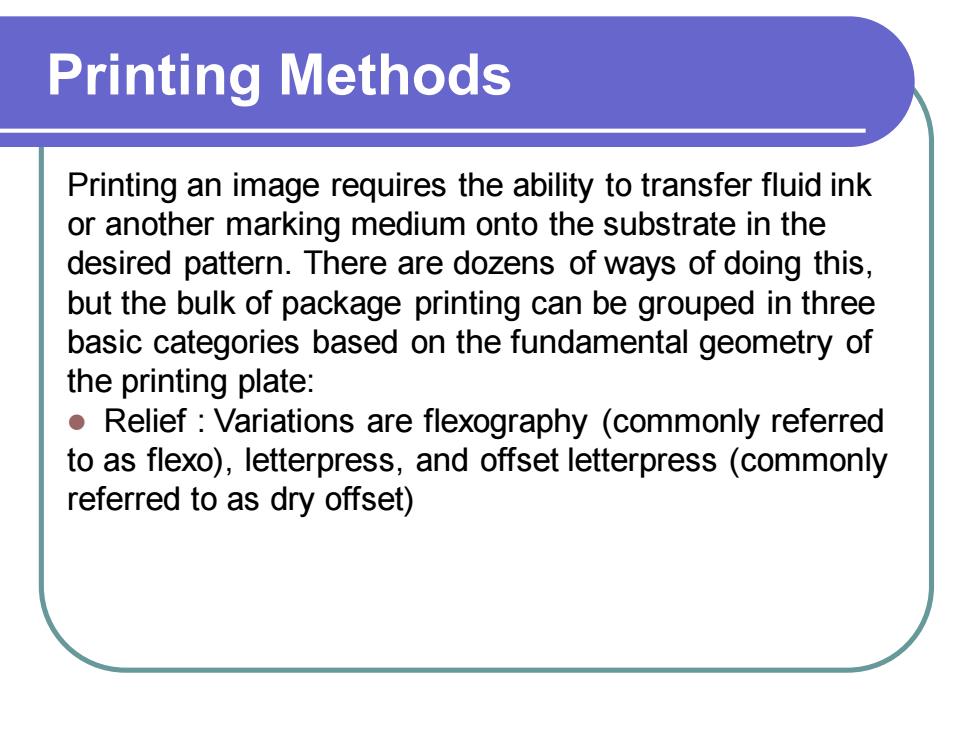
Printing Methods Printing an image requires the ability to transfer fluid ink or another marking medium onto the substrate in the desired pattern. There are dozens of ways of doing this, but the bulk of package printing can be grouped in three basic categories based on the fundamental geometry of the printing plate: ⚫ Relief : Variations are flexography (commonly referred to as flexo), letterpress, and offset letterpress (commonly referred to as dry offset)
Printing Methods Printing an image requires the ability to transfer fluid ink or another marking medium onto the substrate in the desired pattern. There are dozens of ways of doing this, but the bulk of package printing can be grouped in three basic categories based on the fundamental geometry of the printing plate: ⚫ Relief : Variations are flexography (commonly referred to as flexo), letterpress, and offset letterpress (commonly referred to as dry offset)
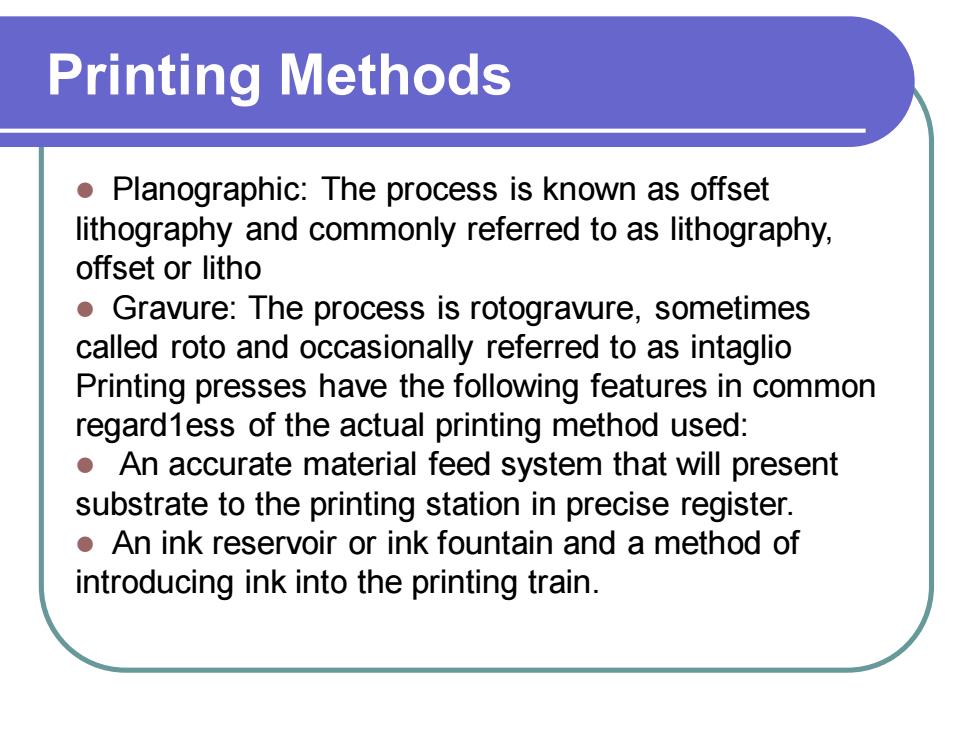
Printing Methods ⚫ Planographic: The process is known as offset lithography and commonly referred to as lithography, offset or litho ⚫ Gravure: The process is rotogravure, sometimes called roto and occasionally referred to as intaglio Printing presses have the following features in common regard1ess of the actual printing method used: ⚫ An accurate material feed system that will present substrate to the printing station in precise register. ⚫ An ink reservoir or ink fountain and a method of introducing ink into the printing train
Printing Methods ⚫ Planographic: The process is known as offset lithography and commonly referred to as lithography, offset or litho ⚫ Gravure: The process is rotogravure, sometimes called roto and occasionally referred to as intaglio Printing presses have the following features in common regard1ess of the actual printing method used: ⚫ An accurate material feed system that will present substrate to the printing station in precise register. ⚫ An ink reservoir or ink fountain and a method of introducing ink into the printing train
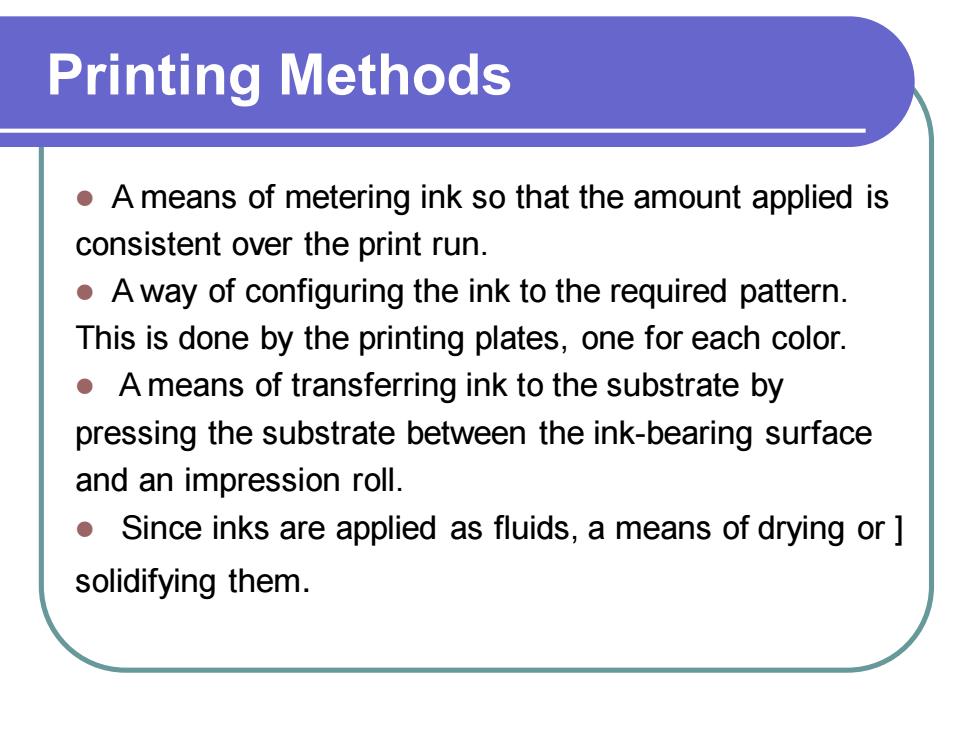
Printing Methods ⚫ A means of metering ink so that the amount applied is consistent over the print run. ⚫ A way of configuring the ink to the required pattern. This is done by the printing plates, one for each color. ⚫ A means of transferring ink to the substrate by pressing the substrate between the ink-bearing surface and an impression roll. ⚫ Since inks are applied as fluids, a means of drying or ] solidifying them
Printing Methods ⚫ A means of metering ink so that the amount applied is consistent over the print run. ⚫ A way of configuring the ink to the required pattern. This is done by the printing plates, one for each color. ⚫ A means of transferring ink to the substrate by pressing the substrate between the ink-bearing surface and an impression roll. ⚫ Since inks are applied as fluids, a means of drying or ] solidifying them
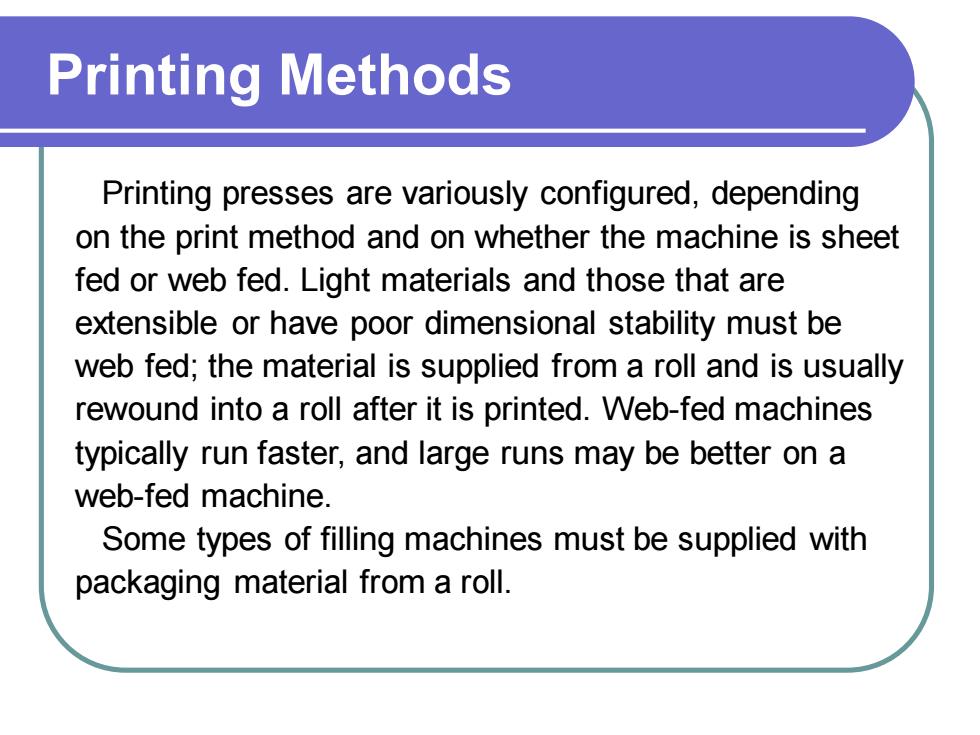
Printing Methods Printing presses are variously configured, depending on the print method and on whether the machine is sheet fed or web fed. Light materials and those that are extensible or have poor dimensional stability must be web fed; the material is supplied from a roll and is usually rewound into a roll after it is printed. Web-fed machines typically run faster, and large runs may be better on a web-fed machine. Some types of filling machines must be supplied with packaging material from a roll
Printing Methods Printing presses are variously configured, depending on the print method and on whether the machine is sheet fed or web fed. Light materials and those that are extensible or have poor dimensional stability must be web fed; the material is supplied from a roll and is usually rewound into a roll after it is printed. Web-fed machines typically run faster, and large runs may be better on a web-fed machine. Some types of filling machines must be supplied with packaging material from a roll
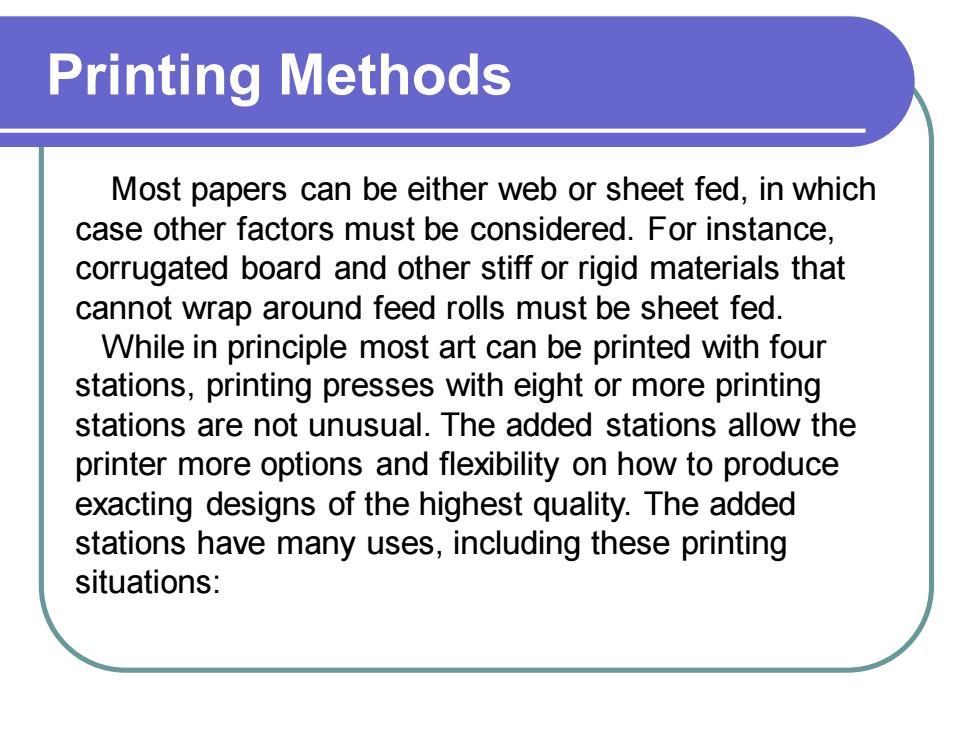
Printing Methods Most papers can be either web or sheet fed, in which case other factors must be considered. For instance, corrugated board and other stiff or rigid materials that cannot wrap around feed rolls must be sheet fed. While in principle most art can be printed with four stations, printing presses with eight or more printing stations are not unusual. The added stations allow the printer more options and flexibility on how to produce exacting designs of the highest quality. The added stations have many uses, including these printing situations:
Printing Methods Most papers can be either web or sheet fed, in which case other factors must be considered. For instance, corrugated board and other stiff or rigid materials that cannot wrap around feed rolls must be sheet fed. While in principle most art can be printed with four stations, printing presses with eight or more printing stations are not unusual. The added stations allow the printer more options and flexibility on how to produce exacting designs of the highest quality. The added stations have many uses, including these printing situations:
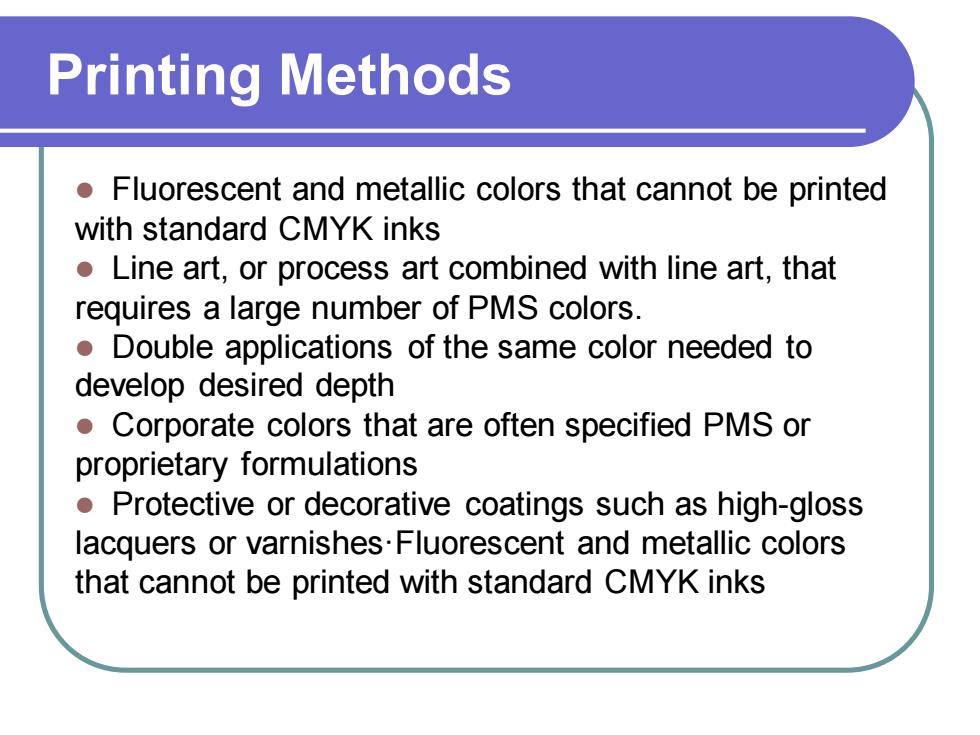
Printing Methods ⚫ Fluorescent and metallic colors that cannot be printed with standard CMYK inks ⚫ Line art, or process art combined with line art, that requires a large number of PMS colors. ⚫ Double applications of the same color needed to develop desired depth ⚫ Corporate colors that are often specified PMS or proprietary formulations ⚫ Protective or decorative coatings such as high-gloss lacquers or varnishes·Fluorescent and metallic colors that cannot be printed with standard CMYK inks
Printing Methods ⚫ Fluorescent and metallic colors that cannot be printed with standard CMYK inks ⚫ Line art, or process art combined with line art, that requires a large number of PMS colors. ⚫ Double applications of the same color needed to develop desired depth ⚫ Corporate colors that are often specified PMS or proprietary formulations ⚫ Protective or decorative coatings such as high-gloss lacquers or varnishes·Fluorescent and metallic colors that cannot be printed with standard CMYK inks
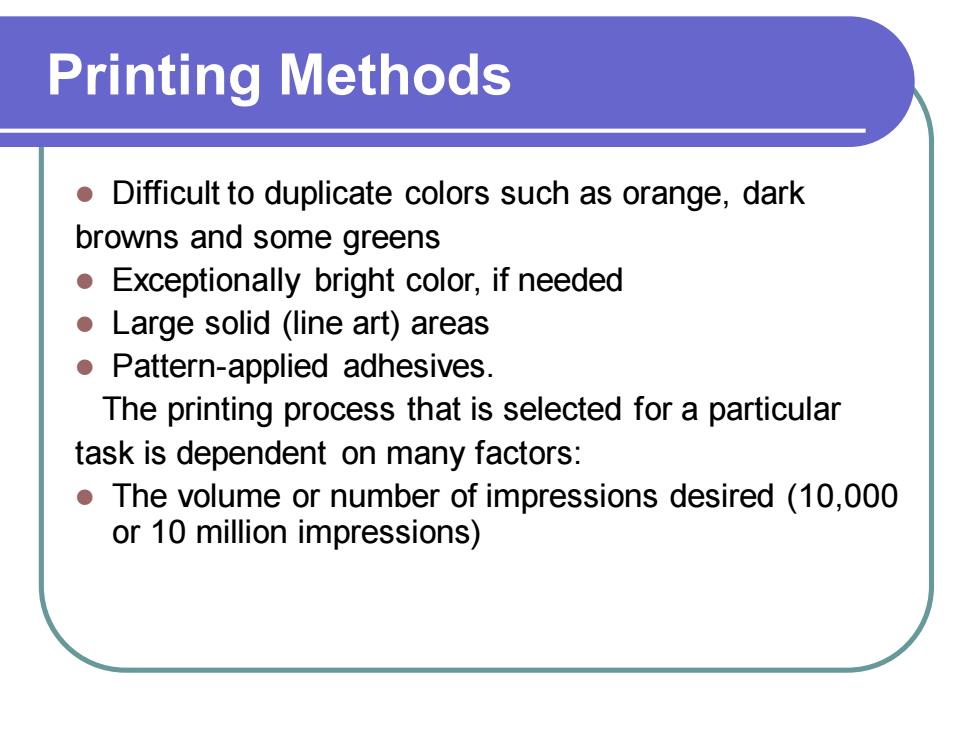
Printing Methods ⚫ Difficult to duplicate colors such as orange, dark browns and some greens ⚫ Exceptionally bright color, if needed ⚫ Large solid (line art) areas ⚫ Pattern-applied adhesives. The printing process that is selected for a particular task is dependent on many factors: ⚫ The volume or number of impressions desired (10,000 or 10 million impressions)
Printing Methods ⚫ Difficult to duplicate colors such as orange, dark browns and some greens ⚫ Exceptionally bright color, if needed ⚫ Large solid (line art) areas ⚫ Pattern-applied adhesives. The printing process that is selected for a particular task is dependent on many factors: ⚫ The volume or number of impressions desired (10,000 or 10 million impressions)
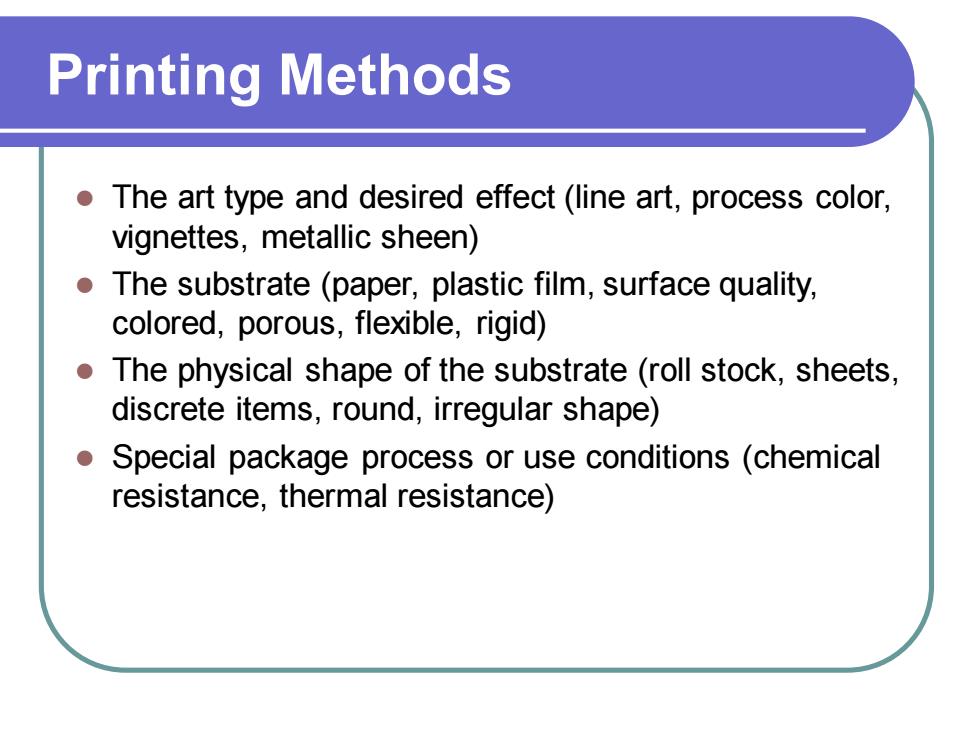
Printing Methods ⚫ The art type and desired effect (line art, process color, vignettes, metallic sheen) ⚫ The substrate (paper, plastic film, surface quality, colored, porous, flexible, rigid) ⚫ The physical shape of the substrate (roll stock, sheets, discrete items, round, irregular shape) ⚫ Special package process or use conditions (chemical resistance, thermal resistance)
Printing Methods ⚫ The art type and desired effect (line art, process color, vignettes, metallic sheen) ⚫ The substrate (paper, plastic film, surface quality, colored, porous, flexible, rigid) ⚫ The physical shape of the substrate (roll stock, sheets, discrete items, round, irregular shape) ⚫ Special package process or use conditions (chemical resistance, thermal resistance)